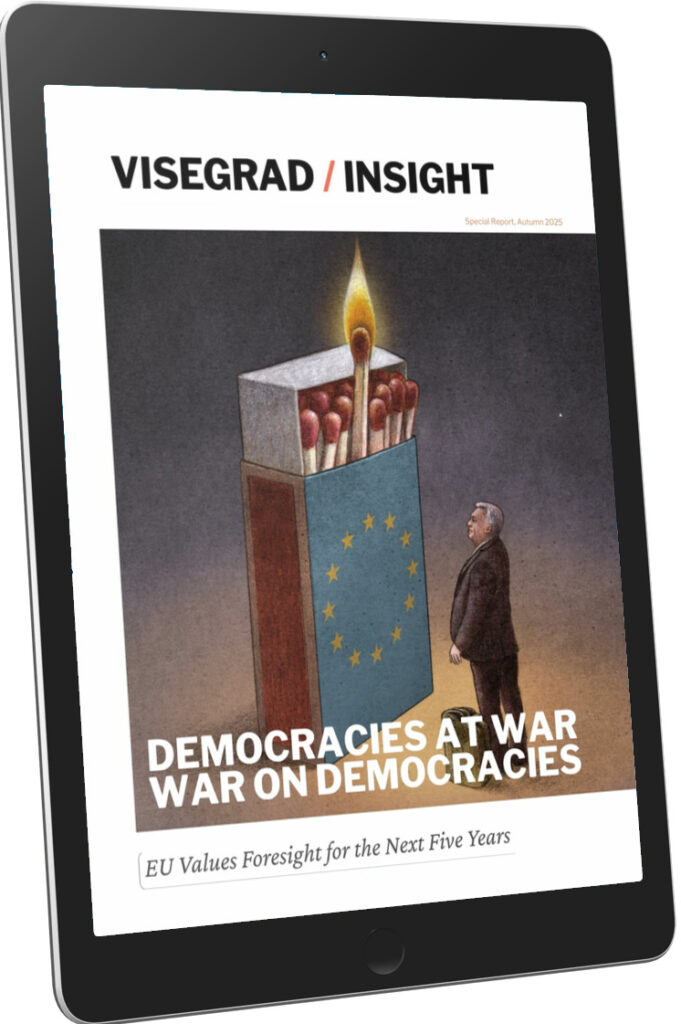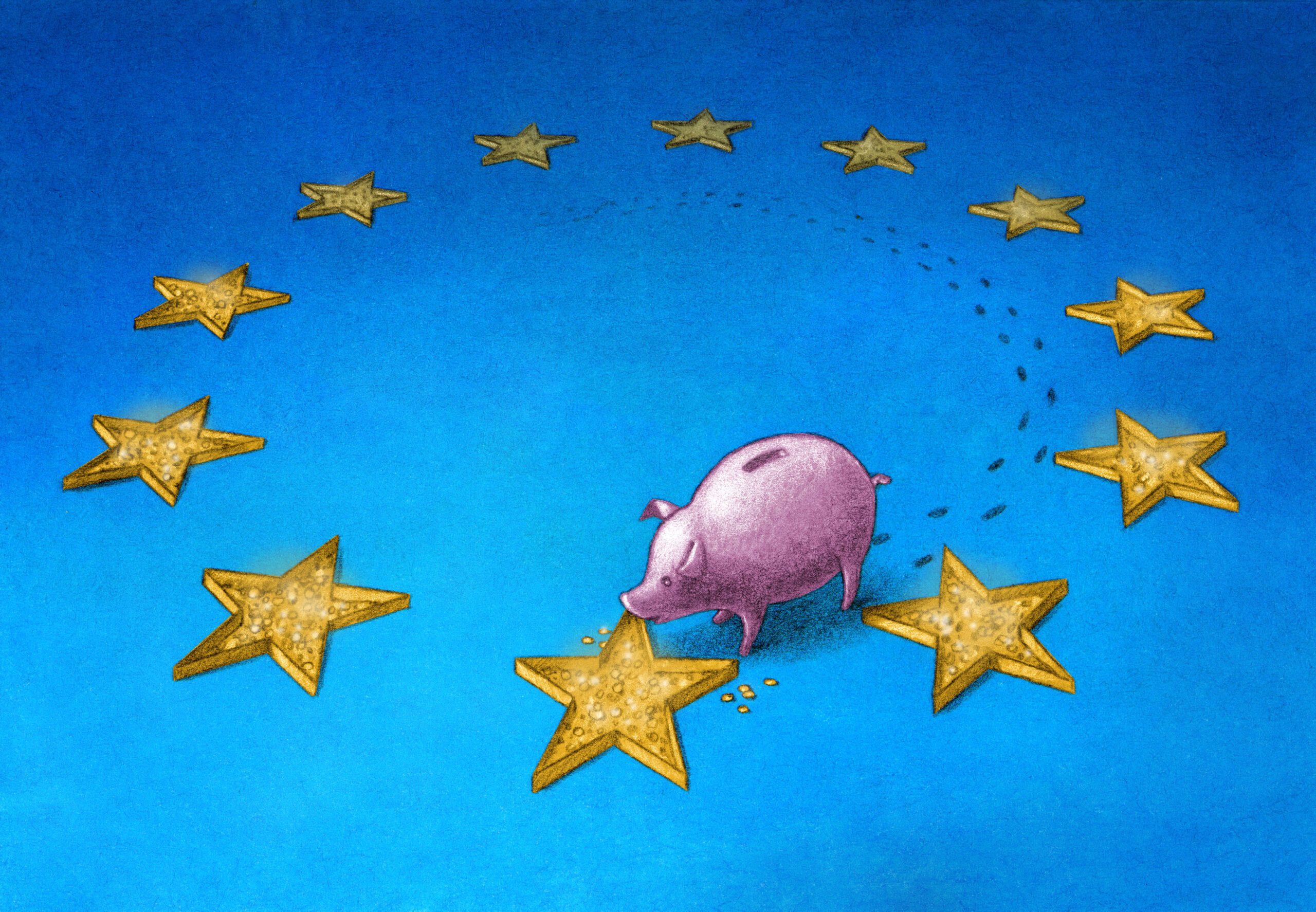
29 October 2025
Navigate to:
EU Values Foresight Homepage
Shielding European Democracy – 2024 Report
How European Democracies Are to Survive a New Trump Age – 2023 Report
Poland’s Reform Blueprint: Lessons for Democratic Renewal in Hungary
Shaping the Debate: How to Secure Our Democracies from Malign Interference
Building Civic Resilience: Challenges and Solutions in Central Europe
Shrinking Spaces: Are NGOs Being Pushed Out of Public Life?
Authoritarian Power Grab in Slovakia – Podcast
Democracy Shield: Europe’s Battles of 2024 and 2025 – Podcast
DIMI in EU. Who’s the Fairest of Them All? – Podcast
Don’t Give Up on Slovakia: Interview with General Pavel Macko – Podcast
Horizon Scanning
Events
To effectively counter democratic backsliding and authoritarian tendencies in challenging security situations, civil society organisations in Central and Eastern Europe need flexible, emergency and core funding schemes, simpler rules and government-independent funding sources. CERV contact points must be set up in all Member States.
Key recommendations include:
Further recommendations regarding the European Democracy Shield:

Click here to download the pdf
In the next five years, the European democratic security landscape – built upon the twin pillars of the EU’s values system and enduring security arrangements – will be transformed. The Russian war in Ukraine and China’s military buildup have compelled EU and NATO member states to effect a paradigm shift in the strategic domain, abandoning globalism with its undeclared destination.
Pressures from partners, rivals and adversaries alike are forcing member states to modernise their defence industries, while the next generation of warfare technologies – predominantly developed outside of the EU – introduces non-linear disruptions to democratic security. Since the COVID-19 pandemic, global trade shocks and economic coercion cases have intensified pressures on economic security, eroding the democratic fabric of European societies. This is compounded by the global trends of demographic decline and the mounting fears of climate disasters wrought by the Anthropocene.
Against this backdrop, while the EU continues to refine its policy toolboxes and maintain order within the European house, ambitious political leaders are pursuing fiercely competitive strategies. These carry differentiated implications for security and foreign policy, delineating divergent end-games for Europe.
The report delineates four principal scenarios for navigating Europe’s strategic landscape over the next five years. These are structured around two cardinal axes: (1) an emphasis on hard power – encompassing military capabilities, defence investment and strategic deterrence; and (2) a steadfast commitment to EU values, advancing democratic norms, the rule of law, human rights, societal resilience and economic integration through open markets and multilateral partnerships.
These axes constitute a conceptual matrix that distinguishes four distinct strategies for reconciling international ambitions with domestic imperatives, particularly amid escalating threats from autocratic regimes and intensifying internal populist pressures.
The scenarios chart pathways for the EU to fortify its democratic foundations whilst addressing pressing defence requirements. They align with flagship initiatives such as the European Democracy Shield, the EU Preparedness Union Strategy and the Civil Society Strategy. These policies, underpinned by robust funding from the current and forthcoming Multiannual Financial Framework, dovetail with the relatively new Defence Readiness Roadmap 2030. Collectively, they seek to cultivate a cohesive approach across Europe’s democratic public spheres, thereby sustaining public backing for the Union’s global aspirations. At the heart of these endeavours lie electoral dynamics, which serve as the primary political drivers shaping the EU’s strategic trajectory.
Developed in collaboration with Central European civil society leaders since 2023, the scenario framework identifies four archetypal political strategies steered by the Union’s elected leadership: (1) a globalist strategy, championing open-world trade and the advancement of global democratic norms with no or very limited hard-power strings attached is considered unsustainable; (2) a Europe-power strategy, marrying heightened defence expenditure with an unwavering fidelity to EU values; (3) a nationalist strategy, propelled by a ‘might makes right’ doctrine that acquiesces to great-power rivalries; and (4) an isolationist strategy, embracing a prudent ‘wait-and-see’ posture – even at the risk of retreating from extant European or international commitments.
Informed by continuous horizon-scanning by a team of Visegrad Insight fellows from across Central and Eastern Europe (CEE), these scenarios have been refined to reflect evolving electoral dynamics in member states and to anticipate the contours of the 2029 European elections, which will determine the composition of the next Commission. As a boundary framework, the scenarios delineate the outermost impact of one or two dominant drivers on the political landscape. Whilst the EU’s actual path is likely to occupy the interstitial space between these poles, the prospect of radical shifts commandeering the agenda cannot be discounted.
This foresight exercise is designed to future-proof EU policies against such contingencies, ensuring resilience and adaptability in a fluid geostrategic environment.
In the lead-up to the 2029 European Parliament elections, Viktor Orbán orchestrates a formidable alliance among nationalist leaders across the EU, leveraging shared grievances against supranational overreach to secure pivotal governments in key member states. This coalition, bolstered by isolationist figures such as Robert Fico, who lend pragmatic support through their emphasis on national retrenchment, reshapes the EU’s institutional landscape. By dominating the Council and influencing the Commission’s composition, they advance the ‘Great Reset’ envisaged in the Mathias Corvinus Collegium report – a profound reconfiguration that repatriates competences to centralist governance of capitals under a false banner of subsidiarity and elevates the primacy of rigged constitutions to support its democratic legitimacy. In consequence, the EU pivots even more towards an intergovernmental model, where opt-outs proliferate and centralised policies in migration, climate and fiscal union are dismantled, ostensibly to safeguard idols of sovereignty against perceived federalist encroachments.
As Russia’s protracted war of attrition grinds on, pushing Ukraine to the precipice of systemic collapse and the US isolationism hollows out traces of Transatlanticism, Orbán seizes the strategic vacuum to imprint his vision upon Europe. The ensuing instability compels NATO to recalibrate support for its eastern members while the same member states grapple with energy vulnerabilities and refugee influxes. In this scenario, the sovereignist endgame materialises – a ‘European Community of Nations’ emerges, characterised by à la carte integration and unanimous decision-making, where Hungary’s illiberal template – prioritising cultural homogeneity and economic nationalism – gains traction. Yet, this triumph carries inherent perils, as internal divisions risk fracturing the single market and global partners exploit growing incoherences in the EU policies.
In the run-up to the 2029 European Parliament elections, mainstream political forces – encompassing centre-right, liberal, green and social-democratic coalitions – exhibit remarkable agility and structured cooperation, honed initially through the electoral battlegrounds of Romania and Moldova in 2024–2025. This enables them to outflank nationalist and far-left populist surges via disciplined messaging, cross-border alliances and vigorous civic mobilisation, whilst neutralising malign foreign electoral meddling through enhanced counter-intelligence measures.
Fortified by EUDS and the EU Preparedness Union Strategy, they secure a functional majority in the Parliament and maintain commanding influence in the Council. Such continuity propels the ‘Europe-power’ paradigm forward, as envisaged in the 2024 Visegrad Insight foresight framework: an amalgamation of bolstered defence capabilities and adherence to EU values. The Commission, emboldened by electoral fortitude, advances defence readiness roadmaps, brokering inter-state compromises to channel unprecedented budgetary allocations into joint procurement, cyber resilience and strategic industrial autonomy – all whilst intensifying rule-of-law conditionality and societal cohesion initiatives to immunise democracies against hybrid threats.
Yet, as Russia’s unyielding war effort persists, draining Ukrainian resilience and straining NATO, the Union’s stabilised frontier becomes a tenuous bulwark, compelling sustained resource commitments that exacerbate economic fissures. Compounded by a deepening Sino-Russian alliance – manifested in coordination of sabotage, circumvention and technological embargoes, raw material monopolies and assertive expansion in the Global South – these instabilities impose escalating costs. Europe delivers resolutely on political freedoms, fortifying democratic norms and human rights amid internal cohesion drives, but at the price of widening economic divergence from nimbler competitors like the United States and Asian powers.
Military expenditure benchmarks are institutionalised beyond mere accounting sleights, interoperability advances and the single market transmutes into a resilient economic security enclave; multilateral ties with democratic allies from Canada to the Indo-Pacific are prioritised, in hope for a pathway to open strategic autonomy. Domestically, civil society endeavours yield dividends, reframing public discourse around collective democratic ethos over fractious identities. This consolidation, eschewing complacency, embodies a reclamation of agency – Europe withstands sovereignist fragmentation and authoritarian emulation, though with the sobering trade-off of subdued growth and innovation lags in a world contested by bigger powers.
In the prelude to the 2029 European Parliament elections, centre-right and liberal formations insidiously appropriate far-right agendas and methodologies to achieve electoral dominance. They co-opt narratives on migration control, cultural preservation and economic nationalism, whilst cloaking them in ostensibly moderate rhetoric. This tactical pivot, refined through lessons from earlier national contests, enables mainstream coalitions to marginalise outright nationalist parties in the short term – fragmenting their voter bases and consigning figures like Orbán to opposition roles in key member states.
By leveraging the EUDS mechanisms not merely for defence but for subtle agenda-setting, these forces retain a commanding parliamentary majority and Council influence, ostensibly advancing a tempered variant of the ‘Europe-power’ paradigm. Yet, this assimilation hollows out the EU’s institutional potential – rule-of-law conditionality becomes mere window dressing for selective enforcement, societal cohesion programmes morph into vehicles for identitarian policies and defence readiness roadmaps prioritise border fortifications over comprehensive interoperability. All whilst diluting commitments to human rights and multilateralism in pursuit of domestic appeasement.
As Russia’s attritional campaign in Ukraine evolves into a frozen conflict, the Union attempts to pursue hard-edged geoeconomic strategies, yet in outright competition with more predatory actors, it is compelled to make increasingly difficult compromises. This includes cosying up to the MAGA-style far-right prevailing in the United States and ceding ground to Russian strategic narratives, which erode the EU’s democratic base and afford Moscow greater manoeuvring room to exert political influence across the Union and its neighbours. European political culture still clings to political freedoms, striving to uphold democratic facades and norms of public discourse; however, the JD Vance-inspired free speech absolutism amplifies radical messaging. It is further harnessed by AI-driven algorithmic power that comes to dominate the public sphere and undermines democratic security from within. In such circumstances, the shrinking centrist liberal messaging either adapts or retreats into isolationism, with occasional electoral victories resembling bitter aftershocks. In effect, Europe succumbs to the full force of the MAGA cultural counter-revolution – albeit unintentionally at first – paving the way for a broader slide into isolationist retrenchment.
Russia’s inability to continue the onslaught, culminating in the war’s end by 2028, Orbán-style nationalists are decisively marginalised, their rhetoric discredited amid a continent-wide yearning for renewal. Mainstream coalitions seize the moment to forge a new socio-economic compact, echoing the post-1945 welfare state premise – of maintaining social peace while opening up for new markets and new labour force to sustain the model through enlargement and a deeper economic integration also across the MENA.
Just as national security imperatives catalysed social protections and economic reconstruction, the EU now assumes a pivotal role in embedding democratic security within an economic model for stagnated markets and growing public debt. Funding societal cohesion becomes the top priority instead of a continued military industrial project, but the post-war instability prevents a more ambitious economic agenda, like energy transformation, that would build up strategic autonomy further. Yet, as post-Putin disorder fragments Eurasia into volatile spheres, Europe finds itself sidelined by the ascendant Sino-American duopoly, relegated to a normative champion advocating EU values in a multipolar fray.
Embracing this humbled stature, the Union pursues a distinctive European path – prioritising economic security mediation in great-power rivalries, from trade disputes to climate accords, while channelling energies into the grand post-war endeavour of continental reunification. The EU enlargement becomes the linchpin for remaining global relevance and self-preservation. This trajectory, far from retreat, reimagines Europe as a mediator, ensuring that democratic and economic security endures not through hegemony, but through resilience and normative influence in an era of geostrategic flux.
The EU’s vision to uphold its values intertwines the EU plans for a Preparedness Union, the next Multiannual Financial Framework (MFF) 2028-2034, the Democracy Shield and the Civil Society Strategy – the policies cross-examined against the backdrop of scenarios mapping discussed with civil society leaders.
Since budgets are statements of values, the MFF is examined first, also in the light of policies it is meant to fund over the next several years.

In the European Commission’s proposal for the MFF 2028–2034, unveiled on 16 July 2025 and totalling nearly two trillion euros, the introduction of the AgoraEU programme marks a commendable step towards bolstering democratic resilience through integrating support for culture, media and civil society – the backbones of European public sphere, as long as the level of funding remains at the proposed level.
With an allocation of 8.6 billion euros, AgoraEU would consolidate existing instruments like the Citizens, Equality, Rights and Values (CERV) programme – doubling its funding to 3.5 billion euros – and emphasise communication as a pillar of societal cohesion, funding cross-border cultural exchanges, media literacy initiatives and innovative civic projects. Should funding for those streams fall under the banner of EUDS, the objective of citizens’ empowerment across the Union would come closer to fruition. AgoraEU’s provisions for creative sectors could enable CSO-led media pluralism efforts, such as digital literacy curricula and AI-driven disinformation detection tools, echoing recommendations for a Democracy Deep Tech Strategy to enhance open strategic autonomy. But it is reasonable to argue that funding democratic security in such a digitally advanced toolkit would require considerable resources, since the EU-wide spending for digital political ads around the 2024 elections on Google and Meta platforms was roughly estimated at 40 million euros, based on the Digital Services Act (DSA) reporting and does not include digital agencies’ costs of production. Russian Foreign Information Manipulation and Interference (FIMI) operations in Moldova in 2024 alone were estimated at 200 million euros. The AgoraEU current figure, divided by seven years of implementation and with a potential 10 per cent allocation for EUDIS scope of activities at best and reduced by projected inflation could just suffice if indeed spent effectively for building up democratic resilience all across the block and in particular in eastern, smaller member states exposed to FIMI without much of their state support to counter it effectively.
Whilst AgoraEU represents progress in recognising civil society as critical infrastructure for democratic defence, it falls short in addressing entrenched disparities, particularly from a Central European perspective, where current funding mechanisms remain insufficient and their application ailing. The proposed doubling of CERV strands is welcome but inadequate to offset vulnerabilities in at-risk Member States like Hungary, Poland, Romania, or Slovakia, where CSOs have faced or currently face legislative restrictions, funding volatility and public vilification as ‘foreign agents’ – exemplified by Hungary’s Sovereignty Protection Act and Slovakia’s 2025 NGO amendment, which impose burdensome transparency reports and erode trust. Comparative analysis reveals stark imbalances: between 2021–2024, ‘Old EU’ states received nearly twice the CERV funding, with Belgium alone securing 42 million compared to 33 million euros for Poland, Slovakia, Czechia and Romania combined, leaving smaller NGOs – often with annual budgets under 10,000 euros – struggling amid bureaucratic hurdles, staff shortages and the abrupt withdrawal of USAID’s Central European programming 31 million euros in 2022 grants. This underfunding hampers creativity in civic engagement, such as innovative fact-checking or media hubs for candidate countries and risks hollowing out institutional potential, underscoring the need for proactive measures like core funding schemes, emergency mechanisms and EU oversight based on Rule of Law Reports to prevent corruption and ensure equitable access.
Ultimately, whilst the MFF proposal advances a values-driven agenda, its feasibility in Central Europe hinges on amplifying AgoraEU’s civil society focus to mitigate economic divergence and hybrid threats, such as those from Russia’s FIMI campaigns targeting electoral integrity. Without targeted enhancements – such as reserving fixed percentages for value-oriented projects in cohesion and defence funds, as advocated in foresight exercises – the programme may perpetuate polarisation, sidelining grassroots innovators and weakening the EU’s holistic defence posture in an era of autocratic pressures.

Amidst persistent democratic electoral system vulnerability to malign meddling and unauthorised or unlawfully amplified operations of influence, the European Union’s quest for comprehensive defence – integrating military capabilities, economic safeguards and societal resolve – is at a continuous risk. At the same time, Europe’s democratic resilience pivots on not merely armaments and fiscal commitments but on nurturing a profound will to defend core values such as freedom, family and a space called home. This existential imperative resonates strongly in Central Europe and frames defence as preserving civilisational integrity against foreign adversaries whose interference has one clear military objective – to erode the defence posture of a targeted member state and of the Union (and NATO) overall.
Recognising that reality, the EUDS, proposed by Commission President Ursula von der Leyen, stands as a cornerstone initiative, safeguarding democratic processes from foreign information manipulation and interference, disinformation, cyberattacks, media suppression and electoral meddling – chiefly from Russia and China but also from other powers who would like to see Europe’s strategic posture more lenient to their objectives – whilst advancing media literacy, fact-checking and civic involvement.
Envisioned as a transformative bottom-up framework, the EUDS should primarily empower citizens as vigilant stewards of democracy, countering the temptation of top-down impositions and defending civic spaces from eroding liberties, legal persecution and state-orchestrated defamation of CSOs, journalists and activists.
EU citizens duties, next to rights and freedoms, are anchored in the Treaty on European Union (Article 2) and the Charter of Fundamental Rights. That’s why it is critical to elevate CSOs to parity with critical infrastructure in bolstering resilience. The Shield must confront autocratic endeavours to eviscerate democratic institutions – figuratively and literally, as exemplified by Russia’s 2022 kill lists targeting Ukrainian civil actors and domestic blacklisting in Hungary, Slovakia and until not long ago also in Poland. This new policy should augment open strategic autonomy, electoral sanctity and unified strategies against malign influences by prioritising CSO empowerment rather than national governments alone, fortifying media pluralism, promoting cross-border erudition and aligning government and civil society stakeholders with the EU Strategic Compass and as well as the EU External Action Service (EEAS) FIMI objectives.
Policy prescriptions for the EUDS encompass establishing a Cross-EU Democratic Resilience Council for CSO-academic-policymaker collaboration, exchanging best practices and monitoring malfeasance. Bolstering CSO-led electoral oversight to detect interference, as in Romania’s 2024 incidents, should not become a norm but a viable option under CERV-funded missions, especially in countries where dominant political parties exploit such vulnerabilities for their immediate electoral advantage.
As mentioned in the above section, this policy must be considered foundational immunity against digitally ever-stronger adversaries, without which political autonomy is in serious jeopardy, has to provide grounds for expanding CERV funding beyond a mere 0.5 per cent of the MFF, incorporating watchdog grants, a Democracy Resilience Fund for institutional and individual support and rapid-response aids against threats.
Furthermore it could and should (1) develop cross-border civic defence and media literacy programmes through Erasmus+ and Creative Europe, emphasising critical acumen and AI literacy per the Digital Services Act and earlier European Democracy Action Plan, (2) advance a Democracy Deep Tech Strategy under Horizon Europe for public-interest digital infrastructure and AI disinformation tools, compliant with the AI Act, (3) foster CSO-political dialogues for co-policy creation, (4) enforce the Digital Sercices Act (DSA), the Digital Markets Act and AI Act expansions, including a Digital Fairness Act for algorithmic oversight, and finally (5) safeguard media pluralism by extending CSO protections to public-interest outlets, invoking the European Media Freedom Act and Anti-SLAPP Directive.
Integral to this would be common European centres of competence, pivoting from resource-intensive reactions to dominating informational arenas. Just as Poland’s non-paper underscores the European Centre for Democratic Resilience as a nexus for whole-of-society coordination, monitoring vulnerabilities and pre-emptive alerts, particularly in candidate nations. Emulating Lithuanian and Czech ‘elves’ – citizen collectives who overwhelm internet trolls via pro-Western dominant discourse – these hubs would orchestrate proactive supremacy, conserving funds whilst eroding adversarial sway. Added value includes citizen empowerment, cross-border innovation, autonomy in CSO funding, holistic defence against hybrids, economic gains from efficient cohesion investments and MFF-anchored continuity.
To avert pitfalls – polarisation via elitist funding, over-regulation alienating publics, static defensiveness, misinformation risks, or reactive failures – the EUDS must proactively tackle AI deceptions. Negligence invites fragmented defences, succumbing to extremist forces easily proliferating online and results in fractured strategic autonomy or inviting wedges between states. Operationalisation demands substantial MFF budgets for platform accountability and CSO elements, lest it devolve into hollow rhetoric – a sign of frailty at best.

Europe’s security and resilience depend not merely on military might but on the active preparedness of its citizens. Yet the EU’s upcoming Civil Society Strategy and its Preparedness Union Strategy remain disconnected – one championing democracy and participation, the other defence and deterrence. Bridging this divide is both urgent and feasible.
The Preparedness Union Strategy, adopted in March 2025, largely sidelines civil society, mentioning it only three times across thirty action points and omitting it entirely from sixty-three implementation goals. The Civil Society Strategy public consultation closed on 5 September 2025, risks becoming a token gesture unless tethered to core priorities like European defence. This matters profoundly as civil society organisations (CSOs) are vital to societal resilience and deterrence by denial. They mobilise trust, counter disinformation and sustain democratic legitimacy, enhancing Europe’s capacity to resist hybrid and grey-zone threats.
Geostrategic rivalry has intentionally blurred lines between war and peace and apart from kinetic direct confrontation, a different type of conflict is currently the dominant form of aggression. NATO defines hybrid threats as coordinated actions blending conventional and unconventional means to create ambiguity across peace, crisis and conflict. Grey-zone conflict occupies the space between, using ambiguous tools to achieve objectives without triggering full-scale war. Adversaries erode defence postures gradually through discord, institutional distrust and norms inimical to open societies. Such tactics may never escalate, rendering them elusive to counter. While resilience is studied in military contexts, civil preparedness against prolonged low-intensity contestation – prevalent in Western and Southern Europe – remains underexplored.
The EU’s whole-of-government and whole-of-society approach, drawn from Nordic models, sets a high standard but falters in practice. Most member states lack readiness for such frameworks and even advanced adopters design civic preparedness for kinetic conflict rather than grey-zone endurance. Here, civil society is indispensable, fortifying defences where arms alone suffice not.
The Commission evidence collected during the consultation process shows a stark disconnect – any direct reference to a civil society role in ‘defence’ is nonexistent while ‘resilience’ is invoked only in the context of normative ideals – not crisis situations. This disconnect reflects broader hesitance – bar specialised think tanks, civil society shies from a security perspective, offering pacifist ideals over pragmatic contributions. The Civil Society State of the Union 2025 Report echoes official whole-of-society rhetoric yet lacks detail on civil protection roles. Marginalised by conservative forces and under-resourced, CSOs must evolve into anticipators, experimenters, watchdogs and visionaries in security landscapes – especially because cohesion rivals armament.
Opportunity lies in linking strategies, but the 2024 Preparedness Task Force is industry-heavy and Action 16 promotes youth preparedness via Erasmus+ and the European Solidarity Corps, a modest start likely to drown in MFF negotiations. Nonetheless, CSOs can do far more, as suggested in our policy brief ‘How Civil Society Can Strengthen Europe’s Preparedness and Defence‘:
Scouts can teach 72-hour survival through badges in shelter, water and signalling – cost-effective community training. Czechia’s 70,000 volunteer firefighters coordinate locally yet act nationally. Estonia’s Defence League channels hobbyists into drone operations for defence. Mid-career and elderly engagement demands a broader associational reach beyond industrial fora.
Conceptually, CSOs advance deterrence by denial – raising adversary costs through societal preparedness at low expense. Imagine the scope of possibilities tested each day by civil society, for instance, crowdsourcing drone sightings via birdwatchers outpaces disruption – Ukrainian civil ingenuity in intelligence and support exemplifies this. CSOs craft pro-democracy defence narratives, ensure procurement transparency and foster nuanced debate tailored nationally. Funding via MFF and national budgets is essential for bottom-up momentum against top-down agendas.
Caution is warranted. CSOs must embrace pragmatism, guard against instrumentalisation and grasp security logics. The defence community must recognise hard power’s limits, invest in societal deterrence and counter radical-right subversion, which undermines democracy and invites foreign wedges. Risks include over-securitisation, polarisation, opacity and premature regulation. Mitigation demands balance, inclusivity and context-sensitivity.
‘Preparedness’ omnipresence should dazzle and yet it was absent from von der Leyen’s State of the Union and the Defence Readiness Roadmap 2030 unveiled earlier, it signals the need for focus. Member states lead nationally; the Commission niches via the Civil Society Strategy, prioritising defence-preparedness with MFF funds. Carve 0.1 per cent from the 150 billion euro Readiness 2030 framework – 150 million euros, the cost of two advanced European-made fighter jets – for an Innovation Fund for Societal Preparedness. Award on a matching basis nationally or unconditionally where rule-of-law falters (Hungary, Slovakia). This catalyses innovation, exchanges and vanguardism – complementing Nordic & Baltic maturity, inspiring others.
Europe’s defence cannot rest on governments and armies alone. Civil society offers networks, creativity and legitimacy to engage citizens and sustain resolve. By connecting strategies, the EU redefines security as a shared civic duty, elevating CSOs from the periphery to strategic partners.

The Preparedness Union Strategy draws inspiration from the Niinistö Report, commissioned by President Ursula von der Leyen. This report, published in late 2024, highlighted the urgent need to enhance both civilian and military preparedness amid Russia’s war in Ukraine and other global instabilities, underscoring that such efforts are a shared European responsibility rather than solely national ones. But the ongoing war is only one of the impulses for the plan, along with the lessons from the COVID-19 pandemic, where EU-Member State coordination proved vital. Overall, it calls for a ‘preparedness by design’ culture embedded across all EU policies.
In essence, the strategy addresses the EU’s vulnerability to ‘polycrises’ – interconnected challenges that demand a unified 360-degree awareness and response. The strategy is the most holistic approach to democratic security in Europe to date, outlining seven action areas to be applied across member states in the best way that fits their specific situation, but coordinated on the EU level:
The Preparedness Union strategy would transform Europe into a ‘Union of hedgehogs,’ which merges civil and military dimensions – providing a defence posture deterring the aggressor by making all of the democratic societies effectively dual-use for civil and military crisis response. But its key strength – a comprehensive and all-encompassing approach – is a political communication weakness and therefore hardly integrated into messaging by top-level EU leaders in the member states, let alone the Commission. Preparedness, therefore, is yet in search of its political sponsors across the Union. Not all can transform into a Nordic-country model, even if many wish so.
In this three-year-long ‘Strategic Foresight from Central Europe on EU Values and Democratic Security’ project, Visegrad Insight, published by the Res Publica Foundation, aims to promote EU values, primarily in Central European states through a dedicated framework, involving civil society actors and policy leaders taking part in strategic foresight reflection that addresses policy questions relevant for strengthening the Union’s democratic security.
This project aims to elevate the quality of public and expert-level debate on the future policy directions in the EU in the context of democratic security and common EU values, while nurturing collaboration amongst civil society as a means to further embed democracy and its resilience in the region.
We engage in activities such as scenario-building, yearly foresight reports, conferences and media appearances to improve discourse on EU values and foster collaboration within civil society. Leveraging our position, Visegrad Insight drives a CEE-wide public foresight debate on future scenarios for democracy, freedoms, elections and social cohesion, bringing together thought leaders, academia and policy-makers. Our primary goal is to address the decline in public debate caused by a lack of information sovereignty, limited trust in democratic institutions and political polarisation, offering solutions and reinforcing support for democratic values.
In 2023, our foresight work centred around the upcoming EU Strategic Agenda to inform the European Council on key vulnerabilities of the democratic set-up in Europe in a prospective (then) comeback of Donald Trump to power. In 2024, it gathered the following three main topics – all linked to the potential implementation of the Democracy Shield concept:
The outcomes of this research and consultation are presented in this report and regular activities:
Navigate to:
Shielding European Democracy – 2024 Report
EU Values Foresight Homepage
How European Democracies Are to Survive a New Trump Age – 2023 Report
Poland’s Reform Blueprint: Lessons for Democratic Renewal in Hungary
Shaping the Debate: How to Secure Our Democracies from Malign Interference
Building Civic Resilience: Challenges and Solutions in Central Europe
Shrinking Spaces: Are NGOs Being Pushed Out of Public Life?
Authoritarian Power Grab in Slovakia – Podcast
Democracy Shield: Europe’s Battles of 2024 and 2025 – Podcast
DIMI in EU. Who’s the Fairest of Them All? – Podcast
Don’t Give Up on Slovakia: Interview with General Pavel Macko – Podcast
Horizon Scanning
Events